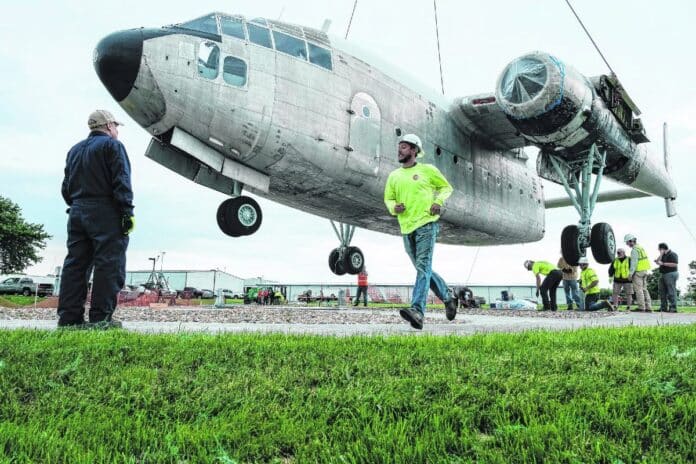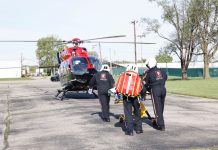
Volunteers at the Atterbury-Bakalar Air Museum, along with the help of the Kentucky Air National Guard, Force Construction and others, have moved a C-119 “Flying Boxcar” aircraft the museum purchased in 2019 to a display site near the Columbus Municipal Airport.
The 40,000-pound plane, which is not airworthy, was taken apart last year at an airport in Greybull, Wyoming, where the aircraft’s parts were loaded onto trucks and driven 1,460 miles to the Columbus Municipal Airport. At a restoration hangar, much of the aircraft has been gradually reassembled and restored over the course of several months.
On Tuesday, a crane from HR Marlin was used to lift the 32,000-pound fuselage about four to five feet off the ground and carry it about 0.75 miles from a hangar off Warren Drive to its display site just south of the McDonnell Douglas F-4 Phantom II aircraft now on display near the museum, said Skip Taylor, a museum member who is co-leading the C-119 project.
“It’s out there,” Taylor said. “…It feels good to have (the move) done. You know, two years ago, we acquired it and then we worked to get the parts here and we worked with the community to get various elements of help.”
“We’ve had all kinds of people just helping us out every step of the way,” he added.
Next, the volunteers plan to install the outer wings and propellers on the aircraft, fix some leaks, paint the aircraft and work on the interior.
When fully assembled, the C-119 will be considerably larger than the F-4 Phantom currently on display. The C-119 is about 86 feet long, has a 110-foot wingspan and is 27 feet tall at the tail. By comparison, the F-4 Phantom is about 58 feet long, 16.5 feet tall and has a wingspan of nearly 38.5 feet, according to the aircraft’s manufacturer.
There is no estimated timetable for when the interior of the aircraft will be ready for the public to see, Taylor said.
The C-119, also known as the “Flying Boxcar” due to the unusual shape of its fuselage, was in service with the U.S. Air Force from 1947 to 1972 and was designed to carry cargo, personnel, litter patients and mechanized equipment. The aircraft was also used to drop cargo and troops using parachutes, according to the Strategic Air Command and Aerospace Museum.
The Flying Boxcars were powered by two Wright R-3350 Duplex Cyclone radial engines, each with 3,500 horsepower, and could reach a maximum speed of 296 miles per hour.
The U.S. Air Force extensively used C-119s during the Korean War from 1950 to 1953. Retired C-119s were also used as air tankers to fight wildfires in the United States.
The particular C-119 purchased by the museum was built in Hagerstown, Maryland, for the Canadian Air Force, Taylor said. The aircraft was later acquired by Hawkins & Powers and used to fight forest fires. Its last known flight was in 1990.
The Flying Boxcars are of particular historical significance to Columbus, according to museum volunteers. Here, the pilots referred to them as the “Dollar Nineteens,” according to museum records.
From 1957 to 1969, 36 C-119s for the 434th Troop Carrier Wing were stationed at Bakalar Air Force Base, which is now Columbus Municipal Airport. The C-119s were a staple in Columbus, flown out of the base longer than any other aircraft.
Manufacturers Fairchild and Kaiser built 1,151 of the C-119s from 1949 to 1955. However, only around 40 Flying Boxcars are still left today, most of them in museums across the country or in a scrap yard.
The Atterbury-Bakalar Air Museum purchased the plane for $15,000 in 2019.
[sc:pullout-title pullout-title=”Where to learn more” ][sc:pullout-text-begin]
To learn more about the C-119 “Flying Boxcar” project, visit atterburybakalarairmuseum.org/.
[sc:pullout-text-end][sc:pullout-title pullout-title=”For more photos” ][sc:pullout-text-begin]
To view more photos from the project, visit therepublic.com and click on the story to access a gallery.
[sc:pullout-text-end]




